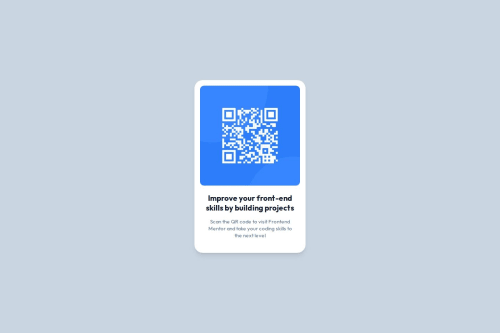QR Component using React, NextJS, and tailwindcss

Solution retrospective
This is my first challenge on this website so I would have to say the thing I'm most proud of is just getting started. I'm primarily a backend and DevOps/Platform engineer although I've always been drawn to UI work. So I'm just excited to be working on what I've always wished I worked on more.
I typically work in type safe languages and I build most of my hobby backends as well as frontends in TypeScript. I wish I would have converted this repo to TypeScript ahead of time. I also would like to get faster at testing UI as I'm less familiar with frontend testing than I am with backend.
I would also extract the QR code component out into an actual React component that I would pass potentially pass the text and QR code to as props if I were building this to reusable, so I'll be refactoring it.
What challenges did you encounter, and how did you overcome them?The only bit that felt challenging to me about this particular component was how to get the white containing div to size how I wanted it to around the image and get the text to look right. I ended up using the tailwind directive max-w-xs to get the white container to shrink down and I'm thinking there is likely a better way to handle it than what I've been able to get working.
I primarily just spent a little bit of time looking through some tailwind docs to see what would might be able to force the dive to shrink down as tightly as it could around the QR code image.
What specific areas of your project would you like help with?I'm clearly no expert in React, NextJS, or tailwind. I know just enough to get things done, albeit likely not the best way. I'd love to get some feedback around how I organized the usage of CSS mostly, although I'd love to see how someone with more experience with tailwind would have organized the className attributes to achieve this.
I was also a bit unsure about the use of the Google font and how I imported it using next/font/google and how I combined it with inline className use. I'd love to see how a someone with extensive tailwind experience would do this.
Please log in to post a comment
Log in with GitHubCommunity feedback
- P@BlonoBuccellati
Great work! I'll use this as a reference. Thank you! I noticed that outfit.className is applied twice in your code. If you apply it to the parent <div>, it will automatically be inherited by both child elements, making the code cleaner. Just a small suggestion—what do you think?
// Before <h1 className={`text-slate-900 text-[22px]/7 ${outfit.className} font-bold`}> {/* some JSX */} <p className={`text-slate-500 text-[15px]/5 ${outfit.className}`}> // After <div className={`px-3 pt-1.5 space-y-4 ${outfit.className}`}>Marked as helpful
Join our Discord community
Join thousands of Frontend Mentor community members taking the challenges, sharing resources, helping each other, and chatting about all things front-end!
Join our Discord